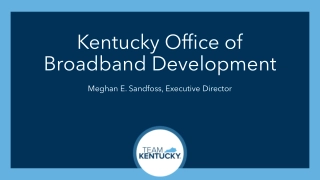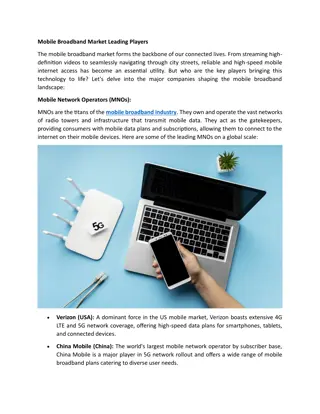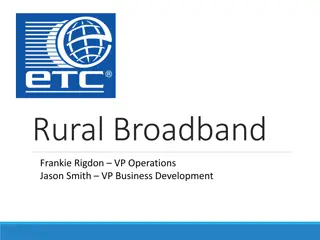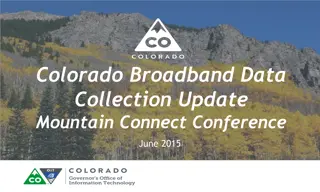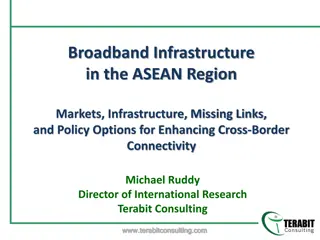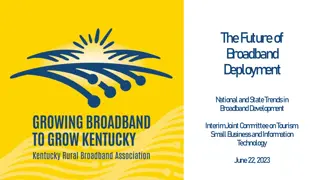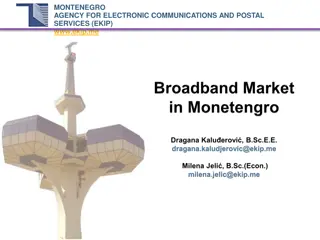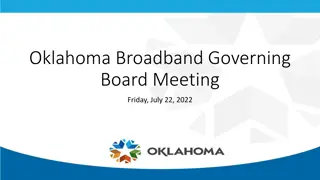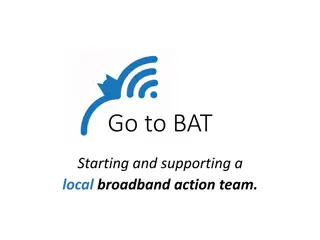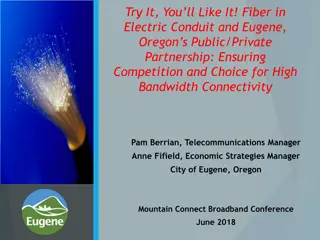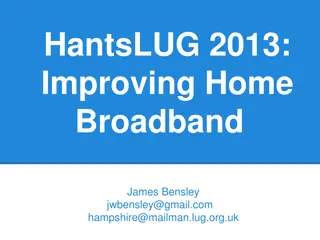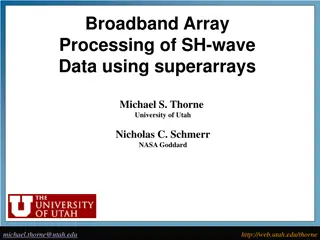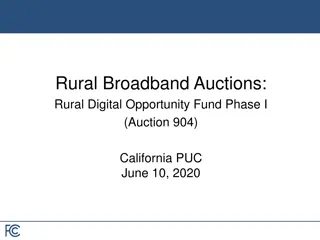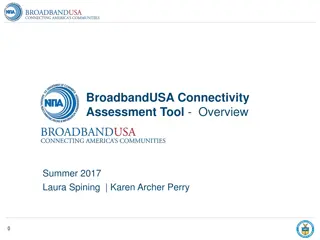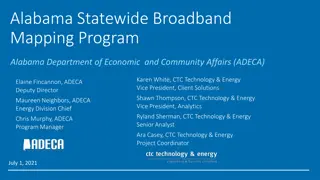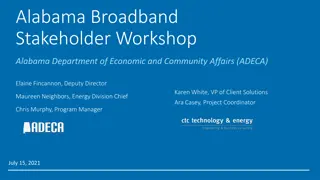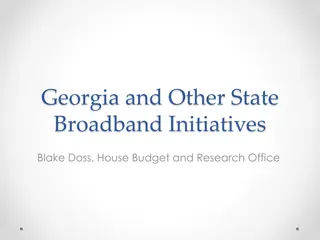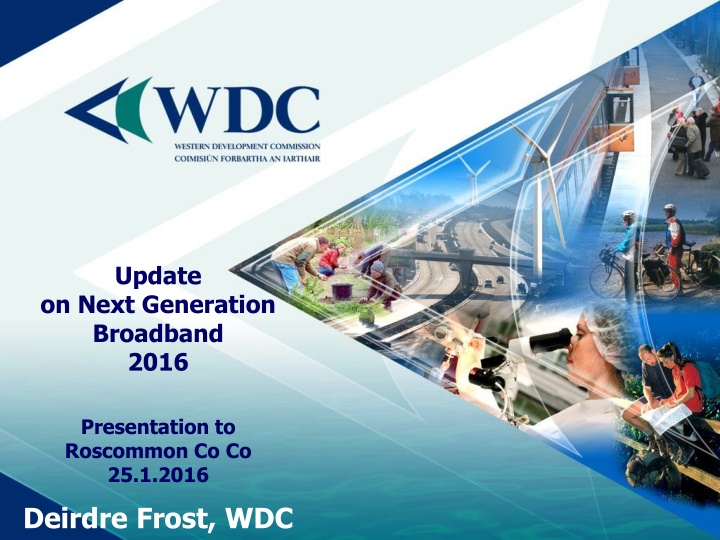
Next Generation Broadband 2016 Presentation
Deirdre Frost from the Western Development Commission presented on the evolution of broadband from 1999 to 2020, highlighting its impact on economic growth and the importance of infrastructure. The presentation outlines past policies, current status, and future projections, emphasizing broadband as a crucial utility for regional development. By exploring the connection between broadband access and job creation, the presentation underscores the need for continued investment in next-generation broadband technologies.
Download Presentation

Please find below an Image/Link to download the presentation.
The content on the website is provided AS IS for your information and personal use only. It may not be sold, licensed, or shared on other websites without obtaining consent from the author. If you encounter any issues during the download, it is possible that the publisher has removed the file from their server.
You are allowed to download the files provided on this website for personal or commercial use, subject to the condition that they are used lawfully. All files are the property of their respective owners.
The content on the website is provided AS IS for your information and personal use only. It may not be sold, licensed, or shared on other websites without obtaining consent from the author.
E N D
Presentation Transcript
Update on Next Generation Broadband 2016 Presentation to Roscommon Co Co 25.1.2016 Deirdre Frost, WDC
Outline of Presentation Outline of Presentation 1. Broadband Where we have come from (1999-2011) 2. Next Generation Broadband Where we are now (2012-2016) 3. Next Generation Broadband Where we are going to and when? (2016-2020)
The Western Development Commission Statutory body, Dept. Environment, Community & Local Government WDC Act 1998 7-county Western Region foster and promote the economic and social development of the Western Region 4 work areas Policy Analysis Regional Dev Initiatives, e.g. renewable, creative Promotion www.lookwest.ie Western Investment Fund risk capital to SMEs
Policy Analysis - Importance of Infrastructure Recent WDC work on regional growth draws on OECD findings which show that: Regions are the drivers of the national economy & All Regions have potential to contribute to economic growth. Persistent regional disparities suggest unused growth potential Infrastructure is a vital ingredient and weaker regions need similar quality infrastructure as is available in more successful regions to compete effectively
1. Broadband Where we have come from 1999 - EU policy of deregulation of Telecommunications sector, sale of Telecom Eireann 2001 WDC The State of the West 2002 WDC Update on Telecommunications
Where we have come from contd Government Policy response to deregulation: County & Group Broadband Scheme CGBS 2003- 2007 MANs 2004 onwards National Broadband Scheme (NBS) 2008-2014 Rural Broadband Scheme (RBS) 2011 -2014
Broadband and Economic Growth Broadband: No.1 priority infrastructure (National Competitiveness Council) Transformative infrastructure & a basic utility; similar to electrification Internet contributes 6% of GDP 75% outside ICT sector 2.6 new jobs created for every job lost through efficiency Jobs impact: Over 8,200 employed in ICT in WR The 2ndlargest sector in terms of assisted employment in WR (13%)
2. Where we are now From Basic to Next Generation/ Advanced EU Digital Agenda Targets 2020 (published in 2010) Government's National Broadband Plan 2012 WDC Connecting the West 2012
Government National Broadband Plan (NBP) Aug 2012 NBP targets Between 70 100 Mbps to more than 50% of pop. (by 2015) 40 Mbps to a further 20% (by 2016) A minimum of 30 Mbps to ALL by 2016 Little detail on which speeds where but industry have outlined some of their plans for commercial investment - usually in higher density areas.
Likely pattern of Next Generation Deployment National Broadband Plan what it might look like Three speed Ireland? Cities: 100 Mbps+ Semi-urban (less than 10,000+): 40 Mbps Rural areas current NBS and RBS: 30 Mbps
Experience of users Differential speeds - implications for different areas Impact for investment both FDI and domestic Companies and residents in rural areas need similar speeds & bandwidth as urban areas Domestic and e-Workers (tele-working, home business) Knowledge intensive businesses including agriculture!! Online sales for all businesses, Video-conferencing 30Mbps only a basic minimum
What are the Issues? Role of state investment addressing market failure Technology choices and implications long term infrastructure - Fibre V Wireless VFM state investment to date Making the case for fibre Investment long-term return 30-40 yrs+ Best ROI Need to conclusively address deficits for the long-term Wireless still important
3. Where we are going Next Steps Government s NBP www.broadband.gov.ie Blue & amber Up to 38% unlikely to be able to access high speed broadband without NBP
Where we are going Next Steps Government s NBP Updated December 2015 State co-investment State-aid issues sanction from EC Procurement process 25 year contract physical build of this network will take between 4 to 5 years to complete
Where we are going Next Steps - Timescale Formal tender process launched, (December 2015) Government decision on preferred ownership model (Q1 2016) State or Private Invitation to Participate in Dialogue (March 2016) Final Tender and approval of Govt for overall strategy (Q3 2016) Govt approval for contract finalisation and commencement of network build (end 2016)
WDC view Need to conclusively address issue Invest in fibre where possible Close monitoring of industry rollout & state support Open access to all state owned infrastructure & effective competition Very strong regulation to support delivery to rural areas Threats funding, electoral cycle Opportunity- Broadband no longer an impediment to living and working in rural Ireland
Thank You Q & A Deirdre Frost Policy Analyst Western Development Commission Tel: 094 986 1441 E-mail: deirdrefrost@wdc.ie

